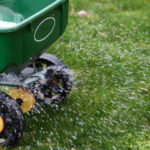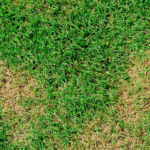Lawn Watering Tips
Water is an essential part of a happy, healthy lawn. It’s important, though, to make sure you water it properly. If you run a sprinkler at night, for example, it sets up the perfect conditions for disease to take hold. If you water too lightly, the grass roots will not grow deeply enough, setting your lawn up for trouble when hot weather hits.
Follow these steps for a hydrated lawn.
When to Water the Lawn
If you find your lawn has taken on a grayish cast or appears to be dull green, it’s telling you that it needs water. You can also check your lawn by walking on it: If your footprints don’t disappear quickly, it’s because the grass blades don’t have the needed moisture to spring back. While it may seem like you can head out to water your lawn anytime during the day, your lawn actually needs more specific care. Watering in the morning (before 10 a.m.) is the best time for your lawn; it’s cooler and winds tend to be calmer so water can soak into the soil and be absorbed by the grass roots before it can evaporate. If you must water in the evening, try between 4 and 6 p.m. which should give the grass blades time to dry before nightfall. The later you water, the greater chance of disease becoming prevalent in your lawn. It’s worth noting, though, that you don’t necessarily have to water your lawn. Lawns are resilient. Established and properly cared-for lawns can survive weeks without water by going dormant (when the lawn turns brown), then recover once the rain returns.
How Much Water to Use
When watering an established lawn, it’s typically recommended to water until the top 6 to 8 inches of soil (where most turfgrass roots grow) is wet. Most lawns need 1 to 1.5 inches of water per week—either from rain or watering—to soak the soil that deeply. That amount of water can either be applied during a single watering or divided into two waterings during the week. Just be sure not to overwater your lawn.
How to Tell If You’ve Watered Enough
Check the Soil
To see how long it will take to soak the soil, check it every 15 minutes during your first watering by using a screwdriver to test how deep the water has moved. Mark the time once the soil has been soaked to a depth of at least 6 inches—that’s how long you’ll need to water your lawn each time in the future. Short on time and simply want to know if you can skip watering for the day? Use this rule of thumb: If you can’t easily stick that screwdriver 6 inches deep into the soil, you need to water.
Do the Math
This is the easiest methodif you have a sprinkler system, since the flow rate (gallons per minute) will be available from the manufacturer. Simply multiply the square footage of your lawn by 0.62 gallons (which is equal to 1 inch of water per square foot), then divide by the sprinkler flow rate. This will tell you the number of minutes to run your sprinkler system.
Measure with Cans
Place clean, empty tuna cans in different spots around the lawn and measure how long it takes to collect 1 to 1.5 inches of water in each can. Since sprinkler coverage patterns may vary throughout the lawn, use the average time it takes to fill all of the cans.
Use a Flow Timer (or water timer)
Choose a timer that measures water flow in hundreds of gallons. Multiply your lawn’s square footage by 0.62 gallons (equal to an inch of water per square foot) to determine the total number of gallons needed for the entire lawn.
When watering your lawn, you may begin to notice that your lawn isn’t absorbing water as quickly as it should. If you find that puddling occurs whenever you water, try watering in shorter cycles until the required time to apply the needed amount of water is met (for example, 10 minutes on, 10 minutes off, 10 minutes on, etc.).
Watering Different Types of Lawns
During the first year of your lawn’s growth, whether it’s a newly seeded, sodded, sprigged, or plugged lawn, don’t rely solely on Mother Nature to do the watering. Additional irrigation should always be provided.
When watering a newly seeded lawn, the key is to keep the top inch of soil consistently moist but not soggy. You will likely need to mist the seeded area once or twice a day (possibly more if it’s hot and dry outside). Once the seeds start to germinate, continue to keep the top 2 inches of soil moist until the new grass reaches a mowing height of around 3 inches. After that, begin to cut back watering to twice per week and soak the soil deeper, about 6 to 8 inches, to encourage the grass roots to grow down deep into the soil.
Keep These Tips in Mind When Watering a Cool-Season Grass Type:
- Tall fescue has a deep root system and the highest drought tolerance of all the cool-season grass types.
- Lawns that are a mixture of Kentucky bluegrass, perennial ryegrass, and fine fescues will go dormant during drought if not watered, but will revive (re-green) when rain returns.
When Watering a Warm-Season Grass Type, Keep These Tips in Mind:
- Zoysia, St. Augustine, bermuda and centipede grasses develop deep root systems, making them better able to withstand drought.
- In general, warm-season grass types require less water than cool-season grasses. Where you live determines how frequently you need to water because of differences in rainfall and summer weather conditions. Grass requires the most water in conditions of heat, drought, low humidity, and high winds.The type of soil you have also plays a part: Clay soil holds water longer and can be watered less frequently than sandy soil, which drains very quickly (and therefore needs to be watered more often).
There are tons of ways to water your lawn, from sprinklers to smart watering solutions. Each has their own sets of benefits, so choose the solution that works best for you and your lawn. Below are a few methods to consider.
Pulsating sprinklers (water guzzlers): These shoot water horizontally at a high velocity so the water isn’t affected by wind.
Hose-end sprinklers: Great for small- to medium-size lawns. There are many different types, so you can choose the one that fits your lawn best.
In-ground sprinklers: These can deliver water in the most efficient pattern. Choose sprinklers that are low to the ground and use a horizontal spray pattern for best results.
Smart watering systems: There are many different types of smart watering systems, and most systems integrate with in-ground sprinkler systems. Many have controllers that allow you to schedule watering using your smartphone and also use real-time weather data to automate watering so you don’t have to think about it.


